Hydrangea arborescens is an ornamental, profusely flowering perennial plant. It is grown in parks, gardens, on city streets and household plots. Looks beautiful in single and group plantings. It is used to create hedges, decorating recreation areas.
Botanical description of hydrangea tree
Tree hydrangea (lat. Hydrangea arborescens) is a representative of the genus Hydrangea, the Hortensia family. There are about 80 species in the genus.
To name a new shrub found on about. Mauritius, during the French round-the-world expedition, was offered by the Prince of the Holy Roman Empire, Carl-Heinrich of Nassau-Siegen, in honor of his beautiful sister, Hortense. But European botanists gave it another name – Hydrangea (Hydrangia). Translated from Greek, it means: hydor – water and angeion – a vessel, which indicates the moisture-loving nature of the plant.
Hydrangea arborescens originates from the eastern regions of North America.
According to its life form, it is a deciduous shrub, reaching a height of up to 1.5–2 m and 2 m in diameter. The bush is upright, rounded. Shoots are straight with gray or light brown bark (young ones are light green in color), smooth or pubescent.
It has a branched root system.
The leaf blade is large (up to 15 cm), broadly oval, with a serrated edge and a heart-shaped notch at the base of the leaf. The leaves are dark green above and bluish below. The leaf arrangement is opposite.
White or cream flowers are collected in an inflorescence shield (photo). Inflorescences consist entirely of sterile flowers, or the latter are located along the edge or scattered throughout the corymb. The flowers are greenish at first, then gradually turn white.

The hydrangea tree is characterized by a fairly long flowering period from mid-July to early autumn. Some varieties bloom until October.
The fruit is a box. Seeds ripen in autumn.
Varieties of hydrangea tree
Traditionally, in different countries, the tree hydrangea was grown exclusively in white or cream color. Today, many varieties have been bred with inflorescences of pink shades from pale to rich dark pink.
Popular varieties with white inflorescences
Hydrangea arborescens Annabelle (Annabelle)


Large, up to 30 cm in diameter, spherical snow-white inflorescences completely cover a sprawling bush. It is noteworthy that flowering occurs in the first year. It grows in height up to 1–1.5 m. The variety is characterized by high winter hardiness. Experienced gardeners advise beginners to start growing hydrangeas with Annabelle. With proper care in one place can grow up to half a century.

Hydrangea arborescens Grandiflora (Grandiflora)
Also an old, American variety of hydrangea tree, similar to Annabelle, but differing in smaller and flatter inflorescences. The plant is fast-growing, can reach a height of 2 m. It blooms in June. The variety is resistant to diseases and air pollution. Suitable for planting along roads and sidewalks.

Hydrangea arborescens Hayes Starburst (Hayes Starburst)
The variety is interesting in that it has double flowers collected in large domed inflorescences. In the photo they are slightly greenish, which indicates the beginning of flowering. Then they turn white, acquiring a creamy hue. The final stage is characterized by a pinkish color. Artificially bred Hayes Starburst, due to its ability to change color and retain its decorative effect for a long time, is very popular, especially in Japan and China. And it is also characterized by ease of care and unpretentiousness to weather conditions.
Varieties of hydrangea tree with pink flowers

Hydrangea arborescens Candybelle Bubblegum (Candybelle Bubblegum)
Differs in abundant flowering. Pink caps 25–30 cm in size gradually change color: by the end of flowering they turn completely white. The green color of the leaves has a pronounced bronze tint. The bush is compact, rounded. An adult plant grows up to 1–1.5 m. It can be grown in tubs, large pots.

Hydrangea arborescens Candybelle Marshmallow (Candybelle Marshmallow)
The most delicate marshmallow airiness is created thanks to the flowers of a light salmon or pale pink hue against a background of rich green foliage. The shrub is characterized by compactness and small height (80 cm), which suggests growing a variety as a container crop. In this case, for a successful wintering, the plant is transplanted to the site in the fall.
Hydrangea arborescens Invincibelle Spirit (Invisible Spirit)


A new, relatively low variety of tree hydrangea (1 m), this can be seen from the photo. It is characterized by excellent frost resistance and disease resistance. Dark pink inflorescences with proper care can reach 30 cm in diameter. In order to create an original contrast, Invisible Spirit can be planted with any white-flowering variety of arboreal hydrangea.
Hydrangea tree care
Growing a tree hydrangea is not difficult, since it is characterized by good winter hardiness and unpretentiousness. The main thing is to choose the right landing site and follow certain rules in care.
Selecting a landing site
This species loves lit places, but cannot stand the bright sun. Grows well in partial shade. This property must first of all be taken into account when choosing a place for the future growth of a shrub.
The editors of flowerbank.info draw attention to the fact that tree hydrangea should not be planted in the shade: flowering comes later and will be scarce both in the number of inflorescences and in their size.
Another important point to consider when choosing a landing site. All varieties have thin shoots and heavy flower caps. In order for the seedlings not to be broken by the wind, they must be planted in a protected place: near the fence, gazebos, walls of the house, retreating from it 1.5 m.
The shrub loves fertile, slightly or medium acid soils. It is advisable to prepare the soil from a mixture of leaf and sod land, peat, sand in equal proportions. To increase acidity, sawdust, peat, and pine needles are added to the soil before planting. Mineral fertilizers are also applied.
If the tree hydrangea is planned to be planted in a row, the planting pits are placed at a distance of one and a half meters from each other so that the plants do not interfere with each other. At the bottom of the pit, up to half a meter deep, drainage is placed in the form of expanded clay or broken bricks. If a seedling with a closed root system (purchased in a pot), it is pre-spilled with plenty of water and removed from the container, lowered into the hole and covered with prepared soil to the level of the root neck.
After planting, watering and mulching are carried out: a layer of mulch is poured around the bush. It can be sawdust, humus, a mixture of sawdust, humus and sand. This is done in order to retain moisture in the soil, protect against weeds and summer overheating, which greatly facilitates care.
When growing perennials, experienced gardeners prefer to use sawdust. This wood product tends to darken over time and become indistinguishable from the color of the substrate, which looks good from an aesthetic point of view.
When growing a tree hydrangea, one must take into account that it tends to grow strongly and will need a support, which can be made in the form of a frame from wooden slats or plastic pipes.
Watering
Hydrangea tree is very fond of water. The frequency of watering depends on the region, temperature, rainfall. The middle lane is characterized by warm, but not consistently hot summers, so it is enough to water 1-2 times a week. In southern latitudes, water every three days in the morning or evening. Water for irrigation should be separated, heated. One and a half or two buckets are poured under the bush.
Do not forget about such an important point in care as “dry watering”. So figuratively called the process of loosening. So that after rain or watering in hot weather a dense crust does not form on the surface of the earth, it is necessary to loosen regularly. For this procedure, use a chopper or hoe. Young seedlings are loosened carefully so as not to damage the roots. As a result, the structure and properties of the soil are improved, aeration is regulated – providing access to oxygen necessary for the respiration of the roots.
top dressing
For the successful cultivation of hydrangea tree, constant fertilization is necessary. During the season, top dressing is carried out 3-4 times. Its appearance depends on the phase of plant development.
In the spring, nitrogen fertilizers must be applied so that the shrub wakes up and starts growing. This is relevant for stimulating delenok, acquired seedlings of new varieties. Nitrogen activates the growth and formation of green mass. Fertilizer (azofoska, saltpeter) is applied to the near-trunk circle directly in the snow in March at the rate of 1-2 tablespoons under a bush.
The next stage in late April – early May: the application of potash fertilizers. Potassium is needed during the period of active growth of young shoots, for the development of the root system. It ensures the resistance of the hydrangea tree to adverse environmental factors, pathogens. The following types of potash fertilizers are applied: potassium sulfate, superphosphate, urea. All of them belong to the granular species. They can be applied to the soil at planting or dissolved in water and used for root dressing.
The general rule for applying fertilizer solutions is to pre-spill the soil with water. This is done in order not to burn the root system. And so that the water does not spread, a circle is drawn around the bush.
Fertilize strictly under the root, trying not to hurt the foliage. The best time to feed: morning or evening.
In June, complex fertilizers are applied. The emphasis is on potassium and phosphorus, the latter is necessary for the plant during the flowering period. You can purchase ready-made complexes marked “Summer” containing low concentrations of nitrogen, because extra shoots and leaves are not needed, the plant must be stimulated to bloom.
In early September, you can feed with potassium-phosphorus fertilizer (20 g of superphosphate and potassium sulfate per 10 liters of water) or last year’s manure, scattering it under a bush.
A complete care for the hydrangea tree also provides for foliar top dressing. They can be carried out throughout the summer season, especially if the plant began to need macro- and microelements. So, with a lack of nitrogen, the entire leaf turns yellow completely, iron and magnesium – the leaf turns yellow, but the veins remain green, if there is little potassium – the leaves seem to be burned at the edges, little calcium – the leaf plates curl, there is not enough phosphorus – a purple tint of foliage and stems.
You can prepare a solution based on a complex fertilizer, for example, Agricola and spray the foliage from a spray bottle in dry, calm weather.
Pruning hydrangea tree
Tree hydrangea belongs to those species in which flower stalks are formed on the shoots of the current year, so she is not only not afraid, but also loves pruning: new shoots will grow quickly and delight with unprecedented flowering.
Annual pruning is perhaps the most basic rule for successful care. It is carried out in spring or autumn, for which they use a pruner and a lopper.
If the gardener chooses the spring option, in the fall it is still necessary to carry out a gentle type of pruning: cut off the withered flower stalks, cut the shoots at least a third of the length so that the fragile branches do not break from the weight of the snow.
Trimming value:
– sanitary cleaning from diseased, dried shoots;
– crown formation;
– bush rejuvenation;
– stimulation of the plant to more lush flowering.
“Important! Saplings of 2 years of age are not pruned. They begin to form the crown only in the third or even fourth year.
autumn pruning
This type of pruning is preferable for beginners, because in the spring you can skip the deadlines and get to the beginning of the sap flow.
The advantages of autumn pruning include destruction along with shoots of insect pests and microorganisms. The root system receives more moisture and nutrients. The plant does not expend energy on maintaining the entire mass of shoots, and it is easier to cover it if it is cultivated in the northern regions.
Falling leaves and frosts in mid-October are the signal to start this procedure. In order to successfully complete it, you need to follow simple rules. Cut out completely:
– dry and diseased shoots (sanitary pruning);
– small shoots around, so as not to take away nutrients and moisture;
– shoots growing inward (removed for the purpose of thinning);
– branches 3-4 years old are cut under the base to rejuvenate the plant.
All other branches are shortened to 3-4 buds. Up to 10 shoots should remain on the bush.
In order to radically rejuvenate an old, neglected shrub, all shoots are cut off completely, leaving stumps 20–30 cm high. It must be borne in mind that there will be no flowering next season. The property of rapid growth helps the hydrangea tree to recover completely in three years.
In order to prevent infection and pests from penetrating the sections, they are treated with garden pitch, charcoal, Bordeaux liquid or oil paint.
spring pruning
If it was not possible to carry out autumn pruning, it must be done in the spring. It is not recommended to skip even one season – this will immediately affect the appearance by reducing the number of inflorescences.
It is carried out in mid-March, when there is still snow in order to be in time before the start of sap flow. Sick, dried branches are removed completely, frozen ones are cut to living tissues, healthy ones are shortened to 2-3 buds. Cut out excess shoots in the thickness of the bush in order to thin out and reduce the load on the soil and resources. Sections of thick branches for disinfection are lubricated with garden pitch or other protective agent.
A video will tell you how to carry out spring pruning of a tree hydrangea:
Wintering
Wintering of tree hydrangea in southern and temperate latitudes takes place without shelter. It is enough to mulch the root zone with foliage, humus, sawdust. In the northern regions, the bush is wrapped with several layers of non-woven material. If the variety is undersized, you can cover it with a wooden box, throwing foliage inside, and additionally lay spruce branches on top.
Hydrangea tree transplant
If the plant has been growing in one place for a long time, more than 10 years, or if it does not suit it, which is noticeable in appearance (it develops poorly, blooms poorly), you need to think about transplanting it. You can transplant this type of hydrangea in spring and autumn.
In a temperate climate, it is better to do this in the spring, so that during the summer season the plant takes root and leaves completely restored for the winter.
In autumn, the transplant must be done before the onset of cold weather, in September, so that the shrub adapts to a new place.
Considering all the requirements that the hydrangea tree puts forward for growing conditions, planting pits are being prepared on the site. The bush is spilled with water, dug in a circle and removed with a shovel with a large clod of earth. The bush can be transplanted as a whole, or it can be divided into identical divisions with the tip of a shovel.
Reproduction of hydrangea tree
For hydrangea tree, as for all plants, two methods of reproduction are characteristic: sexual and vegetative. The result of sexual reproduction is a box with seeds. Growing a plant from seeds is a long and painstaking process.
The following types of vegetative propagation are mainly used:
– dividing the bush;
– cuttings;
– layering.
The division of the bush
This breeding method is simple and reliable. The mother bush is divided in the spring when the plant is transplanted. Each division should have several renewal buds. Before planting, the shoots and roots of daughter seedlings are slightly shortened in order to encourage the growth of lateral roots and stems.
As a division option, reproduction by offspring can be used. Offspring are shoots that form at the root collar. The so-called overgrowth. In the spring, they are carefully separated from the mother bush and grown in a separate bed.
Cuttings
Propagation by cuttings is both due to spring, remaining after pruning, and summer shoots of the current year. The shoot is cut into cuttings with 3-5 buds. They are placed in water with a dissolved growth stimulator (Epin, Kornevin) to speed up root formation and increase protective properties. Either they are immediately planted in pots or in a certain area, covered with glass jars to create greenhouse conditions, not forgetting to periodically ventilate. Rooted cuttings are planted in the garden, covered for the winter, and the next year they are transplanted to a permanent place.
layering
Reproduction by layering is carried out in the spring before the leaves bloom. For this, the soil under the bush is dug up. Grooves are drawn from the branches that are planned to be diverted. Layers are laid in them, which can be pressed with a wire bent in half, covered with earth. In order for the end of the shoot to be located vertically, it must be tied to a peg. Layers are watered. Over time, young shoots will grow on them, which are spud several times, and by September they are separated from the branch. The plants are planted in a separate protected area, in the spring they continue to grow them, in order to transplant them to a permanent place in the same year.
Pests and diseases of hydrangea tree
Hydrangea is considered a disease and pest resistant horticultural crop. However, weather conditions and improper care can provoke their appearance. In order to take the right control measures, you need to know the symptoms of common diseases.
Chlorosis
This is a plant disease in which the formation of chlorophyll (the green pigment that carries out photosynthesis) is disrupted. As a result, the leaf loses color, turns yellow, only the veins remain green, as in the photo. In the future, the leaves curl, the tops of the shoots and inflorescences dry out.

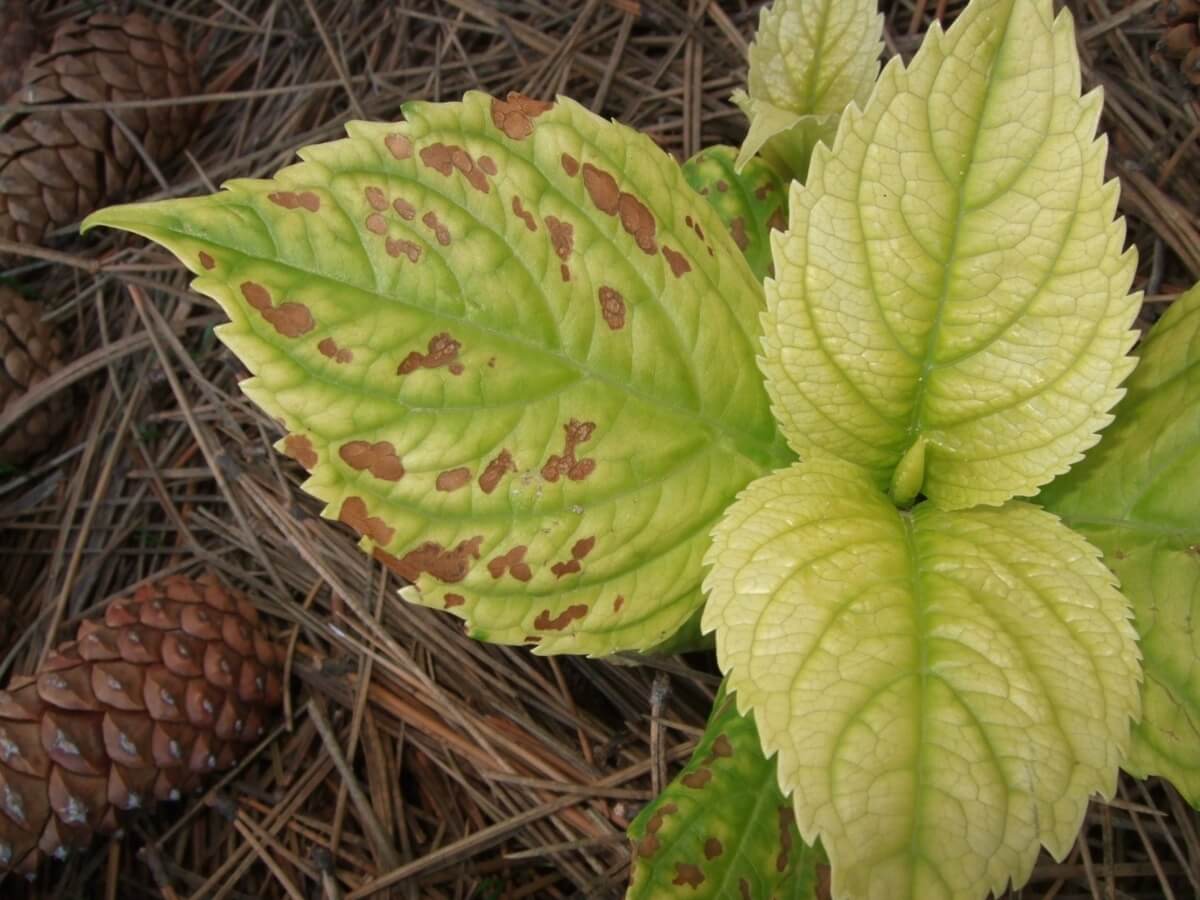
Chlorosis can be the result of a bacterial, viral and fungal infection, as well as improper agricultural practices: lack of iron, magnesium, zinc, nitrogen in the soil, increased acidity. Poor drainage and insufficient space for the development of the root system can also lead to the development of the disease.
For the prevention of chlorosis, timely fertilization, loosening, mulching, and destruction of pests are carried out.
In the early stages, in order to stop the yellowing process, the tree hydrangea is sprayed with a solution of Agricola or Ferovit. Completely yellowed bushes are destroyed.
Fungal diseases of hydrangea tree
“The fungus tends to quickly spread both within one bush and spread to neighboring ones, especially in rainy summer conditions. Regular inspection should be a mandatory item for hydrangea care.
white rot
The causative agent is the fungus Sclerotinia. It affects the root system and shoots of the plant. Outwardly, it manifests itself in the form of a white, cottony coating on the stems, which is clearly visible in the photo.
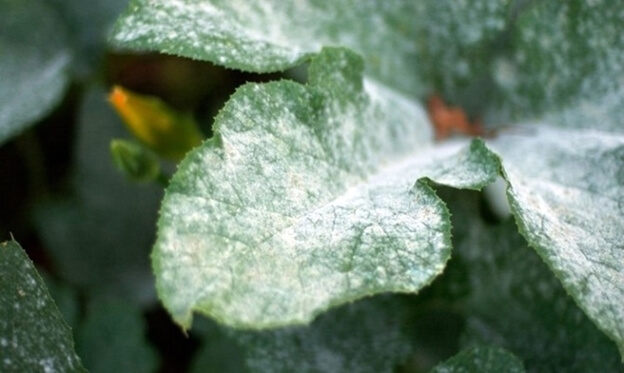

The affected areas must be cut with a pruner and sprayed with copper-containing preparations (Hom, Oksikhom, Bordeaux liquid).
Gray rot
The causative agent is a fungus of the genus Botrytis. Damages leaves and stems of hydrangea tree. First, brown spots appear, rapidly increasing in size. In rainy weather, they are covered with a gray fluffy bloom, in dry and hot weather, the necrosis on the leaves dies off, leaving holes.
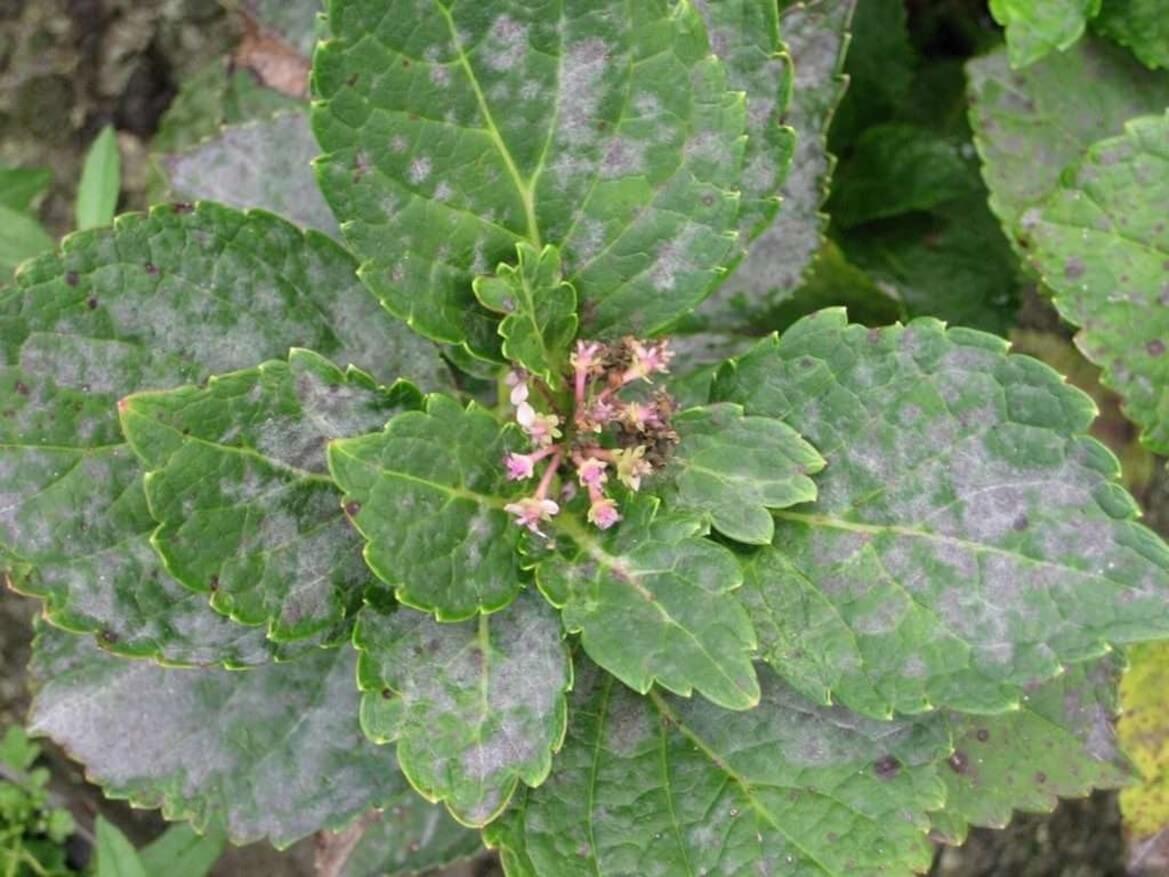

The infected parts of the plant are removed and sprayed with fungicidal preparations Fundazol, Skor, Switch.
White spotting (septoria)
The causative agent is a fungus of the genus Septoria. The photo clearly shows the symptoms of the disease: white spots surrounded by a dark rim. Runaways are also affected. The disease is characterized by the spread of infection from below to the upper branches.


The diseased parts are removed and the plant is treated with Bordeaux liquid or any fungicidal agent.
powdery mildew


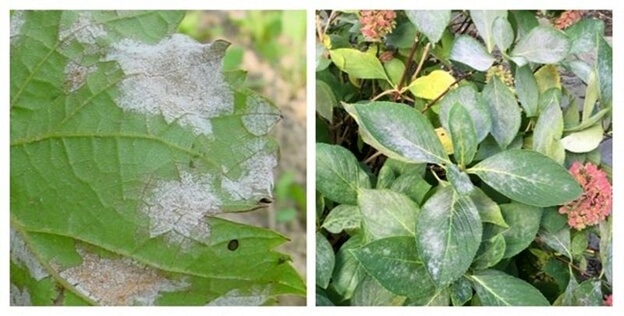
Pathogen – Erizifovy (powdery mildew) fungus. Yellow spots first form on the leaves, then a grayish powdery coating appears on the underside of the leaf blade. Sick leaves are cut off, Fitosporin, Hom are used to treat the bush.
Rust
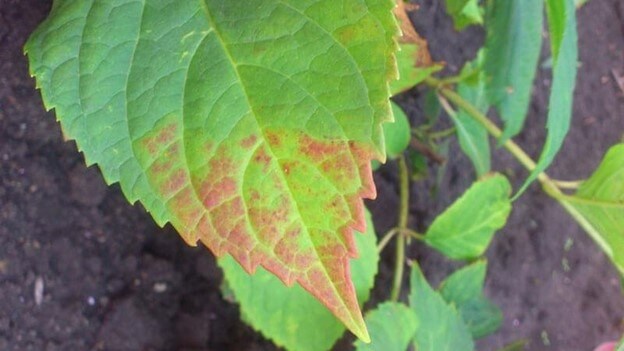

The causative agent is the fungus Heterobazidiomycetes. In the middle of summer, yellow, brown spots can be seen on the leaves of the hydrangea tree, which later turn into growths. The fungus is activated in conditions of high humidity and excess nitrogen in the soil. Control measures are similar to those discussed above.
“To destroy fungal infections, you can pick up one complex drug.”
Hydrangea tree pests
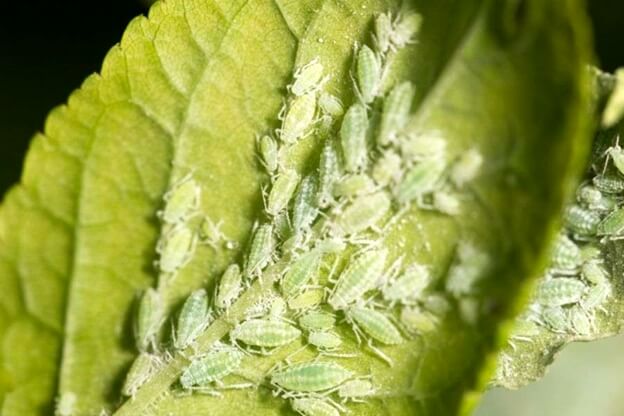
Aphid
These are small parasitic insects belonging to the order Hemiptera. They feed on the juices of the plant, which they attack in whole colonies. They have a high ability to reproduce. To detect pests, you need to lift the leaves and examine their underside, as well as the hydrangea stems. Sticky coating on leaf plates is also a characteristic sign. To destroy aphids, both folk methods (spraying with infusions of celandine grass, tomato tops, a solution of laundry soap) and chemicals (Aktara, Tanrek) are used. In order to scare away pests from the hydrangea tree, marigolds and lavender should be planted nearby.
Spider mite


This microscopic mite is not always visible to the naked eye, but on the back of the leaves one can trace the results of its vital activity – a cobweb. On the web, both the pest itself and its excrement in the form of black dots are visible. Spider mites, like aphids, feed on plant sap and also carry fungal and viral infections. For destruction, they are sprayed with Fufanon, Fitoverm.
Useful properties and contraindications
Hydrangea arborescens is not only a decorative flowering plant, but also a medicinal plant that is used in folk medicine and homeopathy. From the roots, leaves and flowers of the plant, decoctions, tinctures, teas are prepared.
Due to the diuretic, anti-inflammatory, antimicrobial effect, it treats diseases of the genitourinary system (cystitis, pyelonephritis, urolithiasis). Normalizes water-salt metabolism, promotes the removal of excess water from the body and the removal of edema. For these purposes, leaves and young branches are harvested.
The wound healing, antimicrobial, tonic properties of the plant make it possible to use it for the treatment of skin diseases, tonsillitis, tonsillitis, stomatitis. Infusions are prepared from dried inflorescences and fresh raw materials.
In order to prepare a gargle for the throat and oral cavity, you need to pour 1 tablespoon of chopped fresh raw materials with 500 ml of boiling water and insist in a thermos for at least two hours. Strain the infusion, squeeze. You can rinse up to 5 times a day.
To get rid of boils, pustules on the skin, a spoonful of pre-crushed fresh leaves and shoots is poured with a glass of boiling water, boiled over low heat for 10 minutes. Infuse for an hour, filter, for which you can use a sieve or several layers of gauze, dilute with water to bring to the original volume. Used for washing and compresses.
A decoction of the roots relieves the heavy course of menstruation, helps in the treatment of diseases of the prostate gland.
The plant is part of the Uro Lax collection, which is just recommended as a biological food supplement in the complex treatment of diseases of the genitourinary system.
“The general principle of herbal treatment is regular use over several days and even weeks.”
Contraindications to the use of hydrangea tree are:
– individual intolerance in the form of allergic reactions;
– childhood;
– pregnancy and breastfeeding period.
Hydrangea arborescens is an ornamental, profusely flowering perennial plant. It is grown in parks, gardens, on city streets and household plots. Looks beautiful in single and group plantings. It is used to create hedges, decorating recreation areas.







